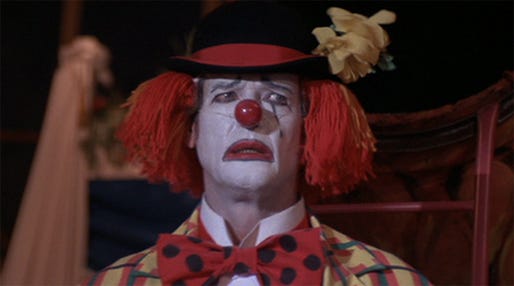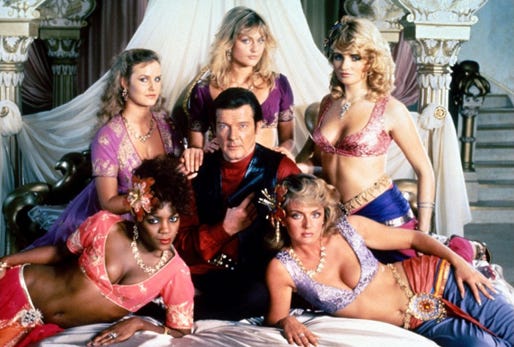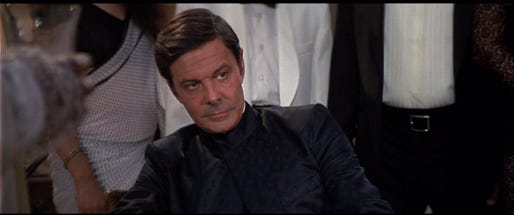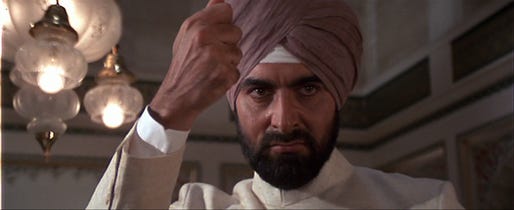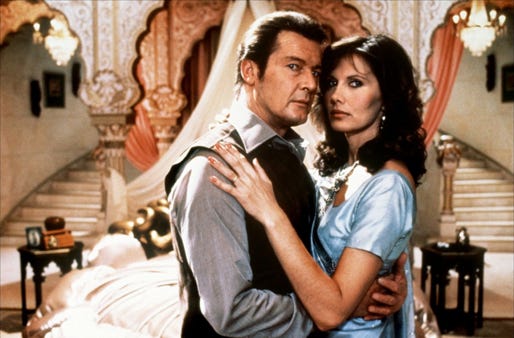You Only Live Twenty-Thrice: "Octopussy"
“You Only Live Twenty-Thrice” is a look back at the James Bond films.
Each Friday until the release of the 23rd official Bond film, “Skyfall,” we will revisit its 22 official predecessors from start to finish, with a bonus post for the unofficial films in which James Bond also appears.
James Bond is old. Wrinkled-forehead old. Lecherous-coot old. Strategic-hairstyle old. Senior meal-discount old. Simply … old.
That’s the biggest takeaway from 1983’s “Octopussy” — Roger Moore’s second-worst outing as 007, hot on the heels of his second-best. Despite a sufficiently vile geopolitical scheme to exploit nuclear disarmament and India’s debut as a Bond destination, “Octopussy” is high adventure in genre name only.
Alan Hume’s cinematography captures the urban blight and bustle of Udaipur as well as the nation’s unspoiled rural majesty. And John Barry’s score — a welcome return after Bill Conti’s rubbish in “For Your Eyes Only” — smartly paints Bond as a stranger in a strange land with passages that are both mysterious and mellifluous.
Too bad “Octopussy’s” other six arms have nothing of which to take hold. The third-rate, third-world chase scenes are cheaply poached from “Raiders of the Lost Ark”; when a camel reacts to an auto rickshaw chase, it’s reminiscent of "Moonraker's" spit-taking bird. And after evading a tiger (by commanding it to sit), crocodiles, snakes, spiders, elephants and nipple-hungry leaches, Bond … well … Bond makes this noise.
The villains are uncharismatic. The love interests are dead-eyed. Action sequences never quite elicit the Douglas Fairbanks-esque derring-do that director John Glen and company are aiming for. And 007 dons a series of embarrassingly awkward disguises — which include a gorilla suit, a circus tunic and the full military ensemble of a Cuban general, right down to the unconvincing pencil-thin ’stache.
The biggest problem, though, is producer Albert R. “Cubby” Broccoli getting far too rapacious with selling the reality of 55-year-old Moore as a man of action. There have been older actors than Moore to have been convincing heroes. But they appear to have planned for such a career. Let’s not be fooled: Moore stuck around for cash, not as a gesture of charity. But a third-party power play placed pressure on Moore to postpone his retirement from the role.
After 1981’s “Eyes,” Moore was talking about hanging it up — having signed his three previous contracts on a per-picture basis. After a run of eight years, five movies and only one true dud, who could fault Moore for wanting to move on? Thus, Broccoli began an atypically public search for the next Bond — once again considering Timothy Dalton, who had passed on the part eight years earlier.
Broccoli also screen-tested Michael Billington, who auditioned for 007 more than any other actor and was allegedly Broccoli’s first choice when Moore wanted to hang it up. Billington’s only appearance would be in 1977’s “The Spy Who Loved Me” as the ill-fated lover of Agent XXX, and with ursine back hair and a soccer-hooligan face, Billington would have been a poor fit for Bond.
American actor James Brolin also screen-tested for the part. Had he been cast, Brolin says, there would have been no attempt at a British accent. On the “Octopussy” DVD, Brolin speaks very candidly, and affectionately, about an experience that probably would’ve killed the franchise. Marvel at how Broccoli averted a truly disastrous decision and, coincidentally, how much 1983 Brolin resembles 2012 Christian Bale.
Undoubtedly, Kevin McClory and Sean Connery were banking on Moore’s departure and a bad choice from Broccoli.
McClory had retained full legal rights to the “Thunderball” story, as well as Bond nemesis Ernst Stavro Blofeld and SPECTRE, Blofeld’s agency of ne’er-do-wells. But in exchange for the rights, and a producer credit on 1965’s “Thunderball,” McClory agreed not to film any variation on the story for the next 10 years. In 1975, McClory wasted no time — collaborating with British writer Len Deighton (of “The Ipcress File” fame) and Connery himself on a script, although the Scot claims he didn’t then intend to star.
Several years of injunctions kept McClory at bay only so long. And when producer Jack Schwartzman (actor Jason’s late father) threw $3 million and profit percentages at Connery, well, “Never Say Never Again” became worrisome for Broccoli.
Fearing he’d lose 1983’s battle of the Bonds by entrusting “Octopussy” to a neophyte, Broccoli wooed Moore back. Although both films found large audiences, “Octopussy” won out, costing $10 million less and earning nearly $30 million more.
But at what price this fleeting victory? Whatever Dorian Gray deal Moore made to look so boyish in his mid-40s seems to have been painted over. Not surprisingly, “Octopussy” begins a two-movie Bond travesty in which the filmmakers don’t even try to use believable stunt doubles — resembling swarthy Italians more than suave Brits.
Bond also spouts off far more disturbing innuendos. When he hands Vijay (Vijay Amritraj), his MI6 contact in India, the pungi Vijay uses in his snake-charmer cover, Bond quips, “Here, you may need this to play with your asp.”
Self-sodomy? Bad form, Commander Bond!
Plus, Moore was already 29 years older than his last love interest; here, he’s almost a libidinous louse in a retirement community — repeatedly zooming a camera on a secretary’s plump breasts. In fact, with Louis Jourdan’s villain checking in at 60-plus, “Octopussy” kind of feels like “The Best Exotic Marigold Hotel” with guns. And the warm-milk texture leaves a sour taste well before he even enters the narrative.
“Octopussy’s” pre-credits sequence — in which a blown-cover Bond escapes Cuban imprisonment thanks to a beautiful ally and a small, nimble aircraft — is only so-so. Pilots and extras expertly convey velocity and chaos leading up to a board-splintering explosion. But Bond’s dogfight with a surface-to-air missile betrays the excitement with tinny, cheap matte effects that diminish any sense of danger.
The sequence then segues into saxophone bleats that wouldn’t have passed muster on a six-episode sitcom. Enter the most ironically named Bond theme — Rita Coolidge’s “All-Time High,” with lyrics by Andrew Lloyd Webber collaborator Tim Rice.
A former wife and musical partner to Kris Kristofferson, Coolidge saw her career peak several years earlier. But Broccoli’s daughter, Barbara, was a fan, and when “Cubby” heard Coolidge, he knew hers was the sound he wanted — an adult-contemporary sound with all the distinction of burnt, unbuttered toast.
Quite honestly, “Family Guy’s” Seth McFarlane is probably the only reason anyone remembers “All-Time High” with anything approaching fondness, thanks to its atonal skewering in his 2012 film, “Ted.”
The endlessly sucking vortex in the opening credits that accompanies “All-Time High” is an apt metaphor for much of “Octopussy.” And are those people … ice-dancing?
“Octopussy” is also the first Bond film with establishing titles, so no one has to infer a setting of East Berlin, where a man in a clown suit clutches a Faberge egg while trying to evade pursuers. It’s never revealed why 009 — the agent dressed as a clown — doesn’t ditch the easily tracked balloons attached to his getup. That would seem to make him easily tracked, especially for Mischka and Grischka (David and Anthony Meyer) — twins who share poofy hair, turtleneck-and-vest ensembles and a talent for embedding knives in their victims’ backs.
When 009 collapses dead at the British Embassy and the Faberge egg is revealed as a fake, Bond is called upon to investigate potential Soviet involvement.
“Octopussy” filmed during a relative lull in the Cold War, but hit theaters just months after President Ronald Reagan announced the Strategic Defense Initiative — a ground- and space-based shield to protect America from a nuclear-missile attack. What you may better remember from its derisive nickname, “Star Wars,” threatened to destabilize the idea of mutual assured destruction — which tended to keep the itchiest trigger fingers at bay.
By happy accident, “Octopussy’s” evil plot plays right into that tension — hatched not by the Bond films’ usual KGB string-puller Gogol (Walter Gotell), but by a new threat, General Orlov (Steven Berkoff). In fact, Gogol is the disarmament peacenik to Orlov’s warhawk, who’s eager to expand the Soviet empire with aggressive military action.
Orlov is particularly stoked about enslaving Czechoslovakia, as evidenced by Berkoff’s overly melodramatic pronunciation of the nation’s former moniker. To fund his violent, sexually explicit experimental theater in Britain, this English actor and director became an ’80s villain extraordinaire — menacing Eddie Murphy in “Beverly Hills Cop” and Sylvester Stallone in “Rambo: First Blood Part II.” Here, Berkoff is in pure hambone mode — not much of a physical foil for Bond to fight.
At least Orlov has a damn good plan: Orchestrate nuclear detonation on a U.S. Air Force base, spur unilateral nuclear disarmament in the wake of the tragedy, and exploit the global relaxation to conquer his enemies.
Where does the Faberge egg come in? Orlov is swiping U.S.S.R. treasures along to Kamal Khan (Jourdan), an exiled Afghan prince turned smuggler extraordinaire who’s selling them to the highest bidder.
Like Auric Goldfinger, Khan cheats at casino games (this time, backgammon). And as Oddjob crushed a golf ball in his hands, Khan’s thug, Gobinda (Kabir Bedi) crushes dice.
After Bond ruffles Khan’s feathers through a series of stink-eyes and furrowed brows, we meet Khan and Orlov’s cohort in smuggling the trinkets into the West. Octopussy (Maud Adams) isn’t just the proprietor of the international circus Khan is using as a front. She’s also the owner of a semi-Sapphic island sanctuary where, when it comes to defending their territory, sisters are doing it for themselves — sometimes in skin-tight Spandex resembling Thing 1 and Thing 2.
Yes, that’s the same Maud Adams who co-starred in “The Man with the Golden Gun” as Francisco Scaramanga’s unlucky mistress. This isn’t the 007 series’ first “Law & Order” moment, but it is the most noticeable. However, Adams is not that good of an actress and Octopussy is not so prestigious a character. Anyone could have played her.
Of “Octopussy’s” 130 minutes — the most in a Bond film since 1969 — precious few are devoted to an allegedly intense connection between Bond and Octopussy. As lip service to Ian Fleming’s source short story — the plot of which “Octopussy” mostly discards — Octopussy is given a backstory about how James spared her traitorous dad an embarrassing death and how said dad gave her a rather peculiar childhood nickname.
That’s about it for foreplay. Moore yanks Adams’ lips to his with greater vigor than any of his past conquests, but there’s no spark between them and yet another self-reliant, self-confident woman turns to Jell-O upon Bond’s touch.
Turns out Octopussy is just a patsy in Khan and Orlov’s plot — unaware they intend to detonate their nuclear bomb during her circus’s USO-esque performance after they’ve escaped miles away.
Scenes when Bond runs atop, dangles from and barely hangs on underneath Octopussy’s circus train in an attempt to foil their plot are easily the film’s most exciting — 007’s shoes scraping against churning mechanics that threaten to swallow him. (And Bond driving a tire-less car on train tracks was also later stolen by “xXx: State of the Union.”)
When his initial effort to defuse the bomb fails, Bond must steal a random woman’s car to infiltrate the base and, to sneak into the circus, he must don the same sort of clown costume 009 was wearing that fateful night.
It’s a decent idea to render Bond a Hitchcockian everyman, struggling to be persuasive of a seemingly ridiculous notion that a nuclear bomb is about to detonate at a circus. And for once in “Octopussy,” a ridiculous get-up works, at least in theory; would you believe a clown with such claims? It’s an unnervingly tense scene, with Bond removing the detonator just as its triggering spokes eject.
Still, the sequence is indicative of “Octopussy’s” slapped-together nature. When Bond arrives on base, he has five minutes before the bomb explodes. In just one minute, he has the threads, fake schnoz and impeccably applied greasepaint to pass for a clown. Maybe Q (Desmond Llewellyn) had a gadget for that in a deleted scene?
Such a device wouldn’t be more absurd than what we’re asked to buy in the climactic action sequence, in which Octopussy seems to have surreptitiously erected her entire circus in Khan’s courtyard to mount a retaliatory siege. At least Q gets in on the action … and showered with affection for his efforts.
Finally, “Octopussy” finishes with an unfortunate recollection of the opening sequence — 007 dangling from Khan’s getaway plane, dropping Gobinda to his death and saving a captured Octopussy, all less convincingly or thrillingly than any of Moore’s previous aerial sequences.
In fact, the film’s most telling scene at first appears to be a throwaway. As Bond scrambles for a ride — any ride — to the Air Force base, he comes upon a car full of teenagers. They slow, as if to give him a lift, and then quickly speed away, heckling as they do — the implications of the young leaving the old haplessly, helplessly far behind not lost as “Octopussy” lurches to a close.
Again, Moore had a fine run as Bond — finer than the credit he’s usually given. It’s too bad that outside circumstances and not a little bit of leading-man pride kept him going past “For Your Eyes Only” … and, unfortunately, past even “Octopussy.”
Next week: "A View to a Kill"
BULLET POINTS
For the pre-credits sequence, pilot J.W. “Corkey” Fornoff pushed his airplane to speeds exceeding 150 miles per hour. And for the scene when it blows through the hangar, a steel pole attached the plane to a Jaguar with the roof removed. Through clever set dressing and stage blocking, neither the Jaguar nor the pole is visible in the final product.
"Octopussy" marks the sole appearance of Penelope Smallbone in any of the Bond films. Playing an assistant to Moneypenny (Lois Maxwell), actress Michaela Clavell was to replace Maxwell in subsequent films. When Maxwell groused, Clavell was dropped ... and never appeared in another movie again.
It also marks the introduction of Robert Brown as M — a role he would hold the rest of the decade through the Timothy Dalton films.
In 1982, it was announced that Sybil Danning, the blonde, buxom Amazonian actress, was to play Octopussy, but talks were never finalized. Faye Dunaway, long courted for a Bond role, was deemed too expensive, and Barbara Carrera turned the part down to star in “Never Say Never Again,” 1983’s unofficial James Bond film.
Maud Adams, eventually cast as Octopussy, appeared in a 2000 episode of “That ’70s Show” as a bridesmaid to series regular Tanya Roberts (who played Bond girl Stacey Sutton in “A View to a Kill”). Joining her was Carrera and Kristina Wayborn (Magda in “Octopussy”).



